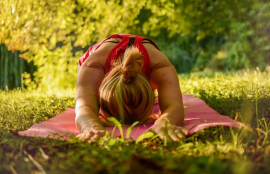 Chances are, you learned to walk when you were just a toddler and you haven’t really thought about it much since. It’s easy to nerd out on other fitness activities, like running or weight lifting. But, walking is something we often take for granted.
Chances are, you learned to walk when you were just a toddler and you haven’t really thought about it much since. It’s easy to nerd out on other fitness activities, like running or weight lifting. But, walking is something we often take for granted.
During the current pandemic, however, walking is having a moment (this article was written in May 2020). A simple stroll can go a long way to clear the mental cobwebs and stop your fitness tracker from screaming at you due to your newfound Jabba the Hutt lifestyle.
Before you start putting in the miles, it’s worth taking a look at how you walk. After all, it’s a repetitive motion and thousands of steps per day can put a lot of stress on your entire body—not just your legs and feet. Here are some tips from orthopedic experts on how to go for a walk without abusing your body.
Understand the Mechanics
Having a clear idea of what a step actually involves can help you visualize how to walk correctly. Every step happens in two phases: stance and swing. Jessica Rose, a professor in the Department of Orthopaedic Surgery at Stanford University and director of the Motion & Gait Analysis Laboratory at the Lucille Packard Children’s Hospital provides the following description: “Typically, the stance phase starts with the leading foot making heel contact with the ground, followed by a heel-toe progression of the weight-bearing foot. The Swing phase starts with rapid hip, knee, and ankle flexion to clear the foot from the ground, the knee then rapidly extends to prepare for the next step. To assist with balance and forward momentum the arms swing in a reciprocal manner, the opposite arm swings forward with the leading foot. A single gait cycle of stance and swing typically lasts about 1-second.”
Your brain does all of that instinctively, but understanding the parts can be valuable in assessing where you might have weaknesses and can help doctors assess any pain you’re having.
Pick the Right Shoes
Choosing the wrong pair of shoes can wreak havoc on your feet, obviously, but those ill-effects can travel all the way up your body. “There’s no perfect shoe for everyone,” says Lew Schon, Director of Orthopedic Innovation Institute of Foot and Ankle Reconstruction at Mercy Medical Center, “but stability is crucial. You don’t want to wear flip-flops or anything that isn’t tight to your foot. They can cause weird stresses and injure your skin.” Blisters from a shoe rubbing against your foot will end your walking initiative in a hurry.
When it comes to padding, though, more isn’t always better. If the sole is too soft, your foot can sink deeply into it and create awkward stresses on your bones and joints and make it difficult to balance. Dr. Schon recommends starting with a standard amount of padding and increasing its thickness if you have a higher body weight. Too much padding, however, can reduce the positive effect the repetitive impacts will have on bone density, which is especially important for older people.
Many shoemakers offer options with corrective structures to try and provide support in needed areas or even correct problems. “You can look at the sole of your shoes and see how your shoes are wearing,” says Wendi Weimar, Director, Sports Biomechanics Laboratory Lab at Auburn. “If they’re wearing too much on the inside, then you might need something that gives you a little more arch support. If they’re wearing more quickly at the heel and causing pain, then you might need a little more cushioning.” She’s careful, however, to explain that it’s not an exact science, especially when you’re doing it on your own. Adding arch support when you have a low arch isn’t necessarily going to fix the issue. A trained orthopedist will use testing and specialized tools.
If you’re unsure about the shape of your step, sticking with a neutral shoe is a good place to start unless you’re having specific pain or are getting a personal assessment.
Tie Your Shoes Correctly
No matter what shoe you buy, tying it correctly will make a big difference in the way it performs. “For a typical eight-eyelet shoe, there are more than 200 ways to tie them based on your feet, walking pattern, and body composition,” says Weimar. “We have tied shoes of people with peripheral neuropathy and it has actually improved the condition. I wouldn’t have believed it if I didn’t see it.”
Weimar suggests starting with a tying pattern known as the runner’s loop, which helps to pull your foot back into the heel of the shoe to reduce its ability to move around. That will drastically cut down on blisters and reduce the chances of an awkward impact on the wrong part of the sole.
Pay attention to whether you’re favoring one side of your body.
It’s possible for your body to have an injury that you won’t even notice and that can negatively affect your body with every step. “If you find that you lean to one side, this may indicate weakness, pain or injury on that side,” says Rose. “We lean over to the weak or painful side, shifting our center of mass to alleviate forces on that limb.” That imbalance can cause problems throughout the body.
If you start to recognize an imbalance, professionals don’t recommend trying to fix it by forcing yourself into the right position because that could make it worse. Rather, finding the underlying cause with a doctor can help eliminate the source of the problem rather than simply addressing the symptom.
Stand Up Straight
Slouching is almost universally bad, but that’s especially true during a walk. “You want to pull your shoulders back, keep your bum tucked underneath you, and your head parallel to the ground,” says Weimar. “When you lift your chin up and stop slouching, it will automatically help bring your head in line with your pelvis.” If you’re used to slouching at a desk all day (like I am) you may actually find that your back, neck, and shoulder muscles feel sore after a long walk since they’re not used to that kind of engagement.
In order to keep your body upright, muscles throughout your body have to activate. “It involves your abdominal muscles as well as your glutei,” says Rose.” They tend to get neglected, but they keep your trunk and pelvis in a good position.” That’s not to say that you have to squeeze your abs and butt as hard as possible as you walk, but they should be engaged, not relaxed.
Keeping your eyes up and parallel to the horizon will also help you keep your balance, which may suffer if you’re staring at a downward angle.
Don’t Try to Force Your Feet Straight
Your feet likely have a natural angle that prevents them from facing perfectly straight ahead. “Your feet point where your legs tell them to,” says Rose. “It’s not something someone should try to correct on their own, but it is something they should try to understand where it’s coming from.” Forcing your feet forward against their natural rotation can put undue torque on the ankles, hips, and feet.
It can become an issue if you’re pushing off with the wrong part of your foot. ”We want the foot to become the best lever it can be. ” says Weimar. “When you roll off the front of your foot, you want the center of pressure to come off between your big toe and your second toe.” Pushing off too far to one side can cause common issues such as bunions.
Choose the Right Surface and Location for Walking
A walk around the neighborhood is great if you have the opportunity because it’s quick and doesn’t require driving. But streets aren’t perfectly flat—they’re sloped to improve drainage—and that uneven surface can be an issue in the long term. “Your outside leg strikes the ground lower than your inside leg. That leg close to the curb strikes lower which is going to cause a mismatched pelvic girdle position and get everything out of whack,” says Weimar. “If you walk out on the right side of the road, walk back on the other to try and even those things out.” She also recommends walking on the flatter part of the street instead of directly in the gutter if you can safely avoid it with traffic.
Walking on slightly irregular surfaces like trails can help build strength in the muscles and joints as your legs adapt to the irregular orientations of each strike. Dirt also provides a softer surface that won’t tax your feet and joints as much.
Hit the Hills
Going up and down hills during your walk can crank up the cardiovascular benefits of a walk, but the technique changes slightly. “When you walk up a hill, you want to lean into the hill,” says Weimar. “You want your center of gravity to get a little bit in front of your feet so when you step, the propulsion part of your step is pushing your body up the hill.”
Coming down the hill requires a different kind of effort from your muscles. “That uses eccentric muscle action, which tends to be a lot tougher on the muscle than concentric,” says Weimar. “A lot of people will get sore from walking downhill because of that new loading pattern.” She recommends going slow and trying not to stomp your feet too hard into the ground.
Don’t Over-Stride
Once you’re a more experienced walker, it’s tempting to try and up your pace and distance. But doing too much can cause problems with your stride and limit your workout capabilities. Taking too big of a stride will require your pelvis to rotate too far to step out in front of you. Plus, as Weimar explains, “it puts stress on your lower back and puts a lot of stress on your heel as it impacts the ground. It also takes more energy to get your body up over that lead foot.” Increasing the overall speed of your steps can help you increase your pace without compromising your technique.
Original article here






















Sorry, the comment form is closed at this time.